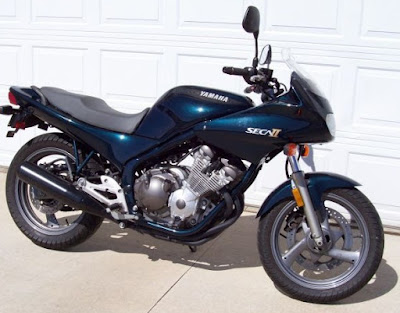Tuesday, December 20, 2016
1992-1998 Yamaha XJ600S Seca II 600cc
Yamaha XJ600S Seca II 600cc
Sometimes we tend to motorcyclists prefer to assume our sport is comparatively proof against the ups and downs of the world’s monetary markets…but it ain’t therefore. ne'er doubt the marketer’s ability to regulate costs in keeping with events way on the far side the comprehension of most mortals.
Back within the late Eighties, the bike OEM bean counters, particularly those in Japan wherever the state was getting into what would convince be a protracted and painful slump, were cognizant of the minor recession that will shortly be touching most of the developed world.
The suits at Yamaha told R&D to develop a reasonable mid-size motorcycle which became the Seca II.
The initial 1992 worth of $3,800 (10 grand in today’s money) was plenty more cost-effective than the $5,200 FZR600 which was a $500 drop from the FZR’s 1991 worth of $5,700. The FZR was a quasi-racer with a 16-valve liquid-cooled engine, subtle twin-spar perimeter frame and full fairing. Whereas the new Seca II used associate cool 4-cylinder, 8-valve motor, a tubular-steel perimeter frame and a 0.5 fairing. In Europe, the Seca II was being oversubscribed because the Diversion, and will be had with or while not a fairing.
The yank street market was sporting mad, and Yamaha felt that this new bike, paying homage to the jazzy models from the late ’70s, would attractiveness to people who wished the image however failed to have the money. It might be thought of a beginner’s sportbike but, in truth, within the hands of a competent rider it might show its car place to a less competent person on a costlier model. Proof of that time is that some house owners of track day faculties found the Seca II quite appealing, and Yamaha was willing to chop quite an deal if anyone wished to shop for a 6 of those bikes.
 |
| Yamaha XJ600S Seca II 600cc |
The in-line four was primarily a brand new engine, if supported recent styles. Sporting a combine of overhead camshafts and a 10:1 compression quantitative relation, some forty five HP at eight,200 rev would be turning the rear wheel. And thirty five lb-ft of torsion at half dozen,200 rpm. A quartet of 26mm Mikuni constant-velocity carburetors fed the combustion chambers, and whereas ridden laborious the consumption may drop to forty mpg, the common was additional like fifty mpg. that meant that the four.6-gallon tank might run the bike overflow two hundred miles. smart sorts would search for a petrol station once the bike went on manual reserve.
One extraordinarily irritating issue was the EPA-mandated excessively lean carburetion—it took a awfully lasting for that engine to heat up. Pull out the choke 2 clicks; push the elaectric leg, and therefore the engine laid-off simply. and therefore the rider might recede slowly if he used no major throttle. once some of miles, push the choke in one click, things got higher. however it took a minimum of 5 miles before the engine warm sufficiently to behave itself. Aftermarket kits to unravel this drawback were shortly on the market.
To aid weight distribution and to offer the fuel mixture a straight shot from carbs to combustion chambers, the cylinders were tilted forward thirty five degrees. Power went from the shaft through primary gears via a multi-disc, wet clutch to the mainshaft, then six gears—in the owner’s manual the counseled shift points were rather low, with 1st to second at ten mph, second to 3rd at fifteen, and third to fourth at twenty. The additional exuberant may simply double that.
The rather horny frame worked well, however the suspension parts were on a budget facet. The 38mm front fork had no changes attainable, and provided an affordable five.5 inches of travel. The rake was twenty five degrees, with a path of three.8 inches, nearly a similar as associate FZR. The solitary Monocross cushion was charged with N, and did have preload adjustment with the suitable tool within the bike’s minimalist toolkit. The shock allowed four.3 inches of wheel travel.
The bike, that itself had a curb weight of 445 pounds, had a rated carrying capability of 440 pounds. it had been capable of carrying 2 individuals well, however anyone curious {about|inquisitive about|fascinated by} going seriously quick was suggested to limit the burden to about 250 pounds. Otherwise the suspension would get quite somewhat mushy, with the fork squishing and therefore the shock bottoming.
Wheels were three-spoke cast-aluminum, with a 110/80-17 tire on the front, a 130/70-18 on the rear. The brake on the front was a twelve.6-inch disc with a dual-piston caliper, then a rather smaller disc and single-piston caliper at the rear. The engineering were smart, with the rider employing a slight bend forward to the virtually flat bar, and even six-foot-plus riders might notice the pegs, seat and bar grips spaced adequately.
The fairing provided cheap coverage and looked quite racy. The engine, absolutely disclosed, gave the bike a rather classic look, from once engines were seeable. Anyone wanting additional fairing might order lowers from Yamaha, similarly as a belly pan, centerstand and roof rack. The list of accessories was long, the maximum amount had been unbroken off so as to stay the value down.
Americans bought an affordable variety of this cut price bike, keeping it on the sales list for seven years. however inflation was talking its toll, and therefore the finish was close to in ’98. By then the value of the Seca II had up to $5,300, whereas the FZR600 was solely $700 additional. The sportier version won out.
Labels:
YAMAHA
Subscribe to:
Post Comments (Atom)
No comments:
Post a Comment
Note: Only a member of this blog may post a comment.